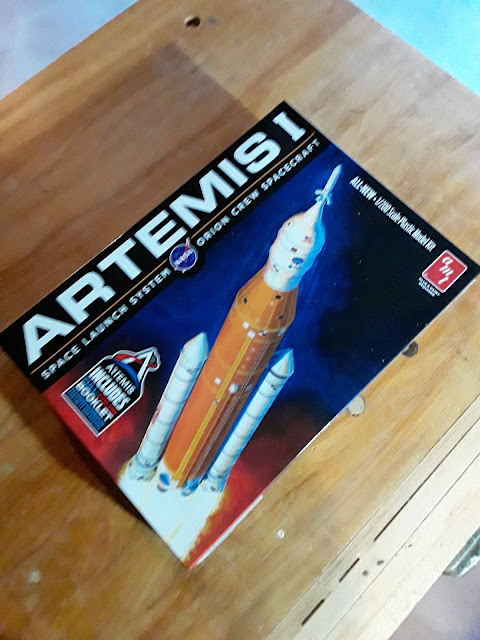For this post I have broken out the parts that will make up the model's main airframes.
The Core Booster:
While dry-fitting the major parts, I quickly noticed how precisely they fit together. They are very well molded with no warping, affording what will be very clean seams when it comes time to use cement. I also noted how clean the parts are - no blemishes or molding flash to be found anywhere. Kudos to AMT's level of QC !
Breaking out my box of various sized Estes body tube scraps, I immediately found that a BT-50 will fit in the airframe as long as the top edges of the molded internal alignment pin posts are trimmed back just a tad.
This means that the model can accommodate 18mm to 24mm motors.
I also found that a BT- 55 will fit in the airframe as long as those alignment features are eliminated entirely.
A cluster of four 13mm motors will fit in such a body tube. Interesting.
If the model is built for single core motor use, a shorter section of '55' can be used in the fore end as a spacious parachute compartment.
The SRBs:
These units can each hold a BT-5 tube as long as the internal pin posts are completely removed. Operational SRBs can be powered by 13mm motors.
Power Configuration Options:
The Artemis I model presents several different ways in which it can be powered, each with successive degrees of complexity, and thus, difficulty in construction and launch operations.
Option 1 - Single core motor with inoperable SRBs
This is by far the simplest configuration which features the least amount of model modification, and no motor clustering.
Option 2 - Single core motor with attached, powered SRBs
This configuration would consist of clustering three motors: a single 18/24mm in the core and a 13mm in each of the SRBs, neither of which would detach during flight. The mini motors would be of the plugged variety.
Option 3 - Core four-motor cluster with inoperable SRBS
Option 4 - Core four-motor cluster with 13mm-powered attached SRBs.
Things are now in the realm of a six-motor cluster!
Option 5 - Core single motor with powered, detaching SRBs.
This configuration will require the addition of recovery systems in the SRBs, as well as a method for allowing them to easily slide off of the core after motor burnout.
Option 6 - Core four-motor cluster with powered, detaching SRBs.
This is by far the most complex arrangement, combining six-motor clustering with release and recovery of the SRBs.
Any route that I choose to go will require a great deal of stability analysis and careful selection of motor types to make things work properly. There's a chance that some of the above scenarios may not even be doable at all.
There is a possibility that I may have to assemble the main parts of the model as a 'boilerplate' flight test version before committing to tackling all the details and painting.
This should be fun!
















































